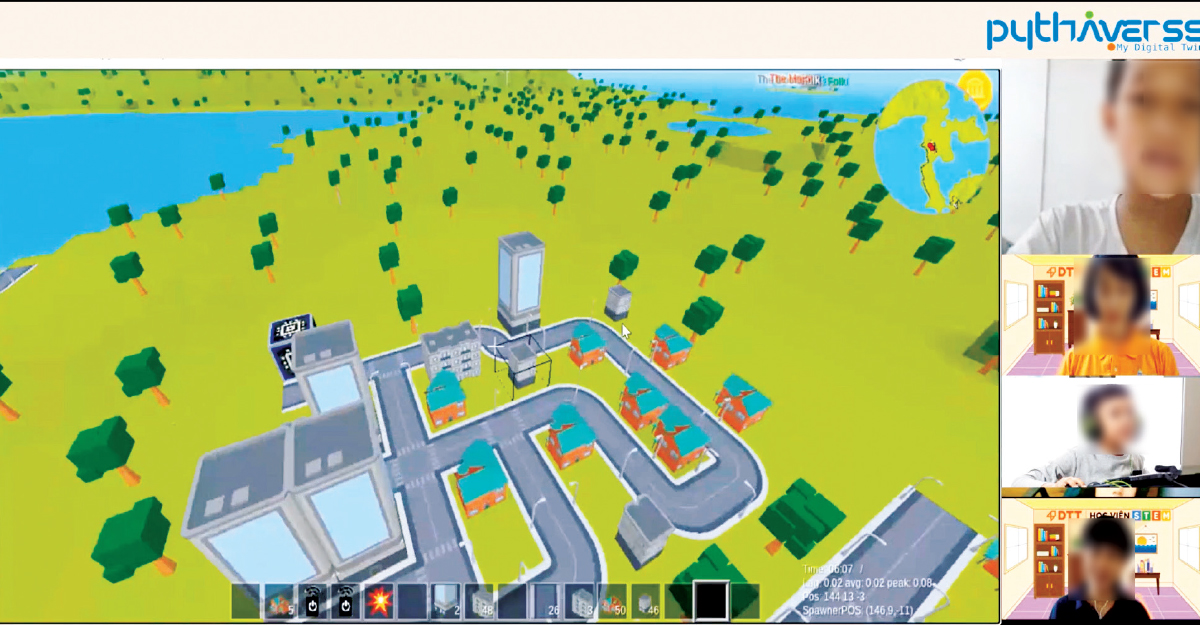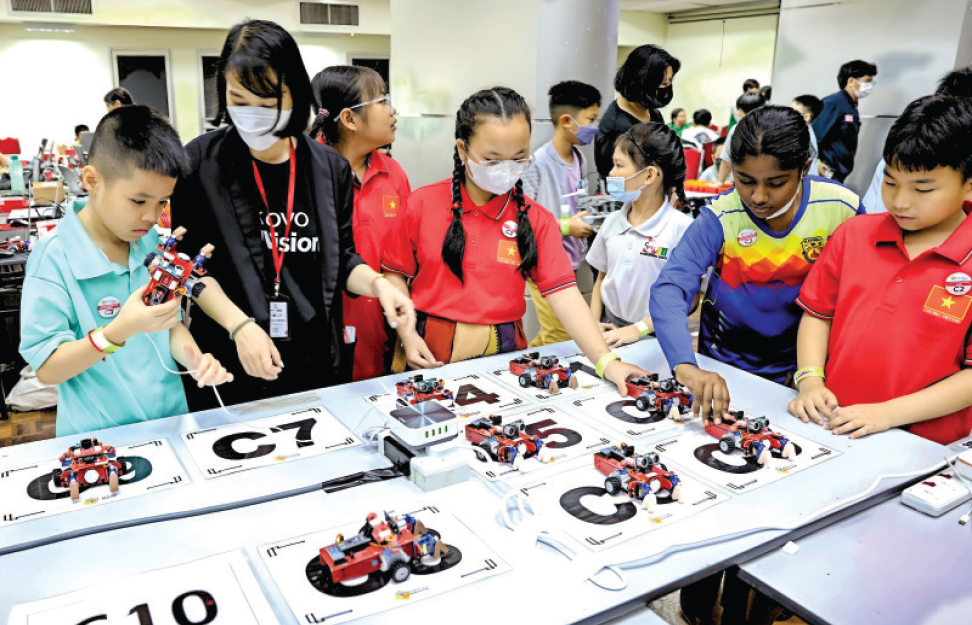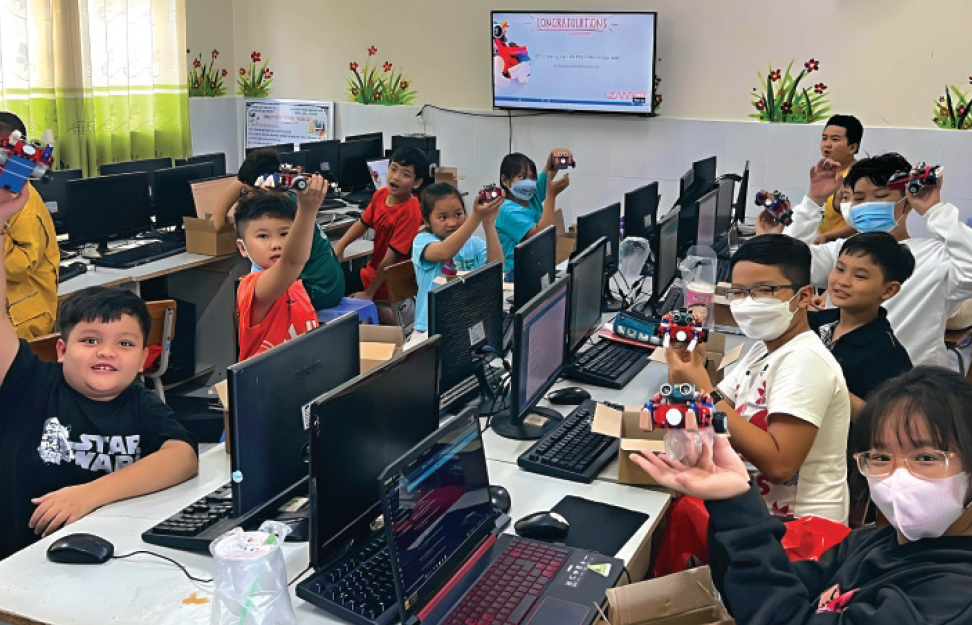
This article first appeared in Digital Edge, The Edge Malaysia Weekly on June 26, 2023 - July 2, 2023
When the Covid-19 pandemic hit, educational technology (edutech) companies swooped in like superheroes to save the day, keeping education going while schools remained closed. But as the world began opening up, these companies were faced with a new nemesis: the struggle to retain their pandemic-era success while remaining relevant. With students returning to in-person learning and the novelty of online education wearing off, edutech companies are having to reinvent themselves once again to stay relevant.
Enter Pythaverse, an educational metaverse that is using digital twin technology to create a cyber-physical learning platform that builds next-generation creators who are technologically empowered.
The name “Pythaverse” encapsulates its founder Nguyen The Trung’s strong conviction that learning can drive the success of future generations. As such, the name can be deconstructed into two parts, says Nguyen — “Pytha”, which draws inspiration
from ancient Greece and the teachings of philosopher Pythagoras; and “verse”, which is commonly understood as a concept denoting a transformative change in our actions, speech and thoughts.
Designed by a team of artificial intelligence (AI), Internet of Things (IoT) and robotics technologists alongside neuroscientists, perspectives educators and social entrepreneurs, Pythaverse revolutionises edutech by extending the learning-by-doing practice to the extreme. Simply put, every student will eventually be a creator who will build and own part of Pythaverse through the latest AI and IoT technology.
The platform is a powerhouse of real-time learning data derived from various sources — this includes tool data such as robot movement and sensors. It connects schools, teachers, parents and students in an immersive and multi-sensor environment that can simulate digital twins of real-world scenarios in virtual spaces.
“The digital twin program in Pythaverse creates a cyber-physical environment and makes use of digital twin technology to cognitively construct a student’s readiness by a standard and modern approach like design thinking and learning by doing,” explains Nguyen.
“This helps students solve problems related to global issues, enabling them to master a thinking framework, the required skill set and iteratively acquire in-depth technical competencies. By using digital twin, students can learn highly engaging tasks, which can be too dangerous, complex or expensive for the classroom.”
These scenarios are personalised to the individual student by utilising learning-logging and preset frameworks based on learning content.
It measures each student’s progress against a learning rubric and competency matrix, with a significant emphasis on student achievement. These tangible outcomes serve as reflections of a student’s real engagement — a vital element that cannot be replicated by mere AI chatbots like ChatGPT.
Nevertheless, the program’s reliance on metaverse tech has raised a few doubts, as more tech experts step forward to express increasing scepticism about the future of the metaverse.
The metaverse was supposed to be the next big thing for Mark Zuckerberg’s Meta but on Feb 27, the social media tycoon ended the project he began in 2021 after it cumulatively lost nearly US$24 billion at the end of last year.
Instead, Zuckerberg turned to generative AI, announcing that the company will now be focusing on “building creative and expressive tools”. This transition sparked chatter that the metaverse is a fading trend rather than a sustainable concept.
Nguyen, however, disagrees, believing the metaverse is still a relevant force in technology. “Pythaverse does make use of the metaverse technology concept in an open way, in that it acts like a platform that can connect different ‘metaverse’ technologies together for the benefit of learners. While some portions of the metaverse are dying, we strongly believe that the internet is changing towards an open, distributed and AI-aided direction.
“The digital twin concept is really the future where cyber technologies can contribute to improve physical world activities — that’s where students need to be ready. With that, you can see Pythaverse is not part of the metaverse hype but has a clear purpose and an open approach,” he explains.
What sets the learning journey in the metaverse apart from standard remote learning tools is the feeling of presence it provides. Pythaverse proves to be the ultimate playground for both students and teachers to explore, engage and experiment with virtual excursions and simulations — it’s a level of presence and immersion that traditional classrooms simply can’t match. And let’s not forget the gamification element, where learning becomes a fun-filled adventure with endless possibilities for collaboration and discovery.
Parents who love customised learning for their children won’t have to worry either, as Pythaverse’s goal is to suit each learner’s unique needs.
However, educators are not easily replaced by machines and algorithms. As such, Pythaverse provides a dynamic pedagogy and different learning progress monitors for different perspectives.
“For example, schools and teachers can define their own matrix and rubrics, and Pythaverse can be queried to provide the relevant data analytics dashboard for those. A gameful mindset also helps students reach immersion levels not found anywhere else. The desire to seek out and appreciate play, where the learning can be taught as playful learning activities, makes the playful discovery a powerful way to explore, understand and learn,” he explains.
NEW APPROACH TO STEM
There are several immersive tools that students can currently use in Pythaverse. These include pHub (a collaborative, high resolution, 3D environment that can provide virtual classrooms, virtual public spaces and workshops) as well as pSim, pLab and pVR for self-learning or educational activities in the classroom.
“These tools provide different applications to bring real-world scenarios to a student’s PC or mobile devices, such as conducting virtual physics, chemistry, math or biology experiments, going on virtual excursions or simulating a scenario-based mission within these subjects,” says Nguyen.
Students can have a single digital identity across these tools, allowing for easy navigation. These immersive experiences are also aided by AI tools to provide interaction through conversational, non-playable characters, or create a multi-sensory environment.
“For example, a physical robot can send sensor data to virtual environments to run its digital twin and also receive virtual sensor data to act accordingly,” he adds.
Pythaverse’s use of technology logs learner activities and links data to learning analytics, allowing for personalised learner profiling and badging. This system enables Pythaverse to suggest advancement to other courses based on a student’s badge score, skills obtained and assessment awards.
And while Pythaverse may have aimed to modernise online STEM (science, technology, engineering and mathematics) learning during the pandemic, Nguyen feels it has a far bigger vision ahead.
“We call it next-generation learning. Pythaverse’s vision is to be the leader in cyber-physical learning platforms that are open and accessible, with a learner-first design. This will help realise [some of the UN’s] Sustainable Developmental Goals and STEM global competence successes for students by enabling them as next-gen technology-empowered creators. We believe this vision fits the next 10 to 30 years of our education process.”
Pythaverse doesn’t take away the much-needed human connection in classrooms, either. Instead, it serves as the ultimate balancing act between the physical and cyber (virtual) realms.
“While remote learning tools helped maintain the continuity of education during the pandemic, it was challenging to sustain student engagement for prolonged periods, mainly due to the absence of interacting with classmates and teachers in a shared space,” Nguyen acknowledges.
Just like social media revolutionised human connections, digital twin technology is poised to bring about a connectivity revolution, not just between humans but also between humans and machines and even machine to machine.
“We are producing more content on global competence, which emphasises the importance of human connection in the new context, especially when we are all connected to global issues and are all learning more about multicultural perspectives. These are concepts that are also well crafted into the Malaysia Madani framework,” Nguyen shares.
“It’s the perfect tool to create a digital ‘twinship’ that replicates the bond between humans, making learning an immersive and engaging experience.”
Revolutionising education, democratising technology
Four schools in Malaysia have already integrated Pythaverse into their existing curricula. More public schools in the Klang Valley enrolled in Pythaverse’s STREAM tournament activities with two separate tracks — the Festive Season Fashion Show and SEA Got Talent! Show in May and June. Some schools are also working towards integrating their robotics and programming clubs to the Pythaverse toolset.
The program is also available in other Southeast Asian countries such as Indonesia, the Philippines and Vietnam, with plans to expand further regionally.
“In Malaysia, SK Sultan Hisamuddin Alam Shah, SK Kiaramas, SMK Damansara Jaya and SMJK Katholik PJ started Pythaverse digital twin robotics learning from the first quarter in 2023. They participated in — and won — the Robothon 2023 with Leanbot, a Pythaverse robotic learning tool with digital twin capabilities,” Nguyen notes with a hint of pride.
According to him, “students can learn anytime, anywhere” with their own personal robot; many have achieved “exceptional results in terms of programming skills, engineering skills and creativity with Pythaverse Leanbot using the pCode, pGit and pNote tools, which are all on the cloud”.
One of the biggest challenges, Nguyen admits, is reaching students from all walks of life. While the platform and most of its digital content are currently free — with much of it accessible using basic computers or Chromebooks — rural schools and lower-income students with limited or zero access to digital infrastructure, electronic devices and internet connectivity are still unable to reap the benefits of e-learning.
“We need to try harder to make it work for disadvantaged communities, among whom we believe there is great potential. Our first attempt with a group of students in Vietnam who had disabilities taught us a lot of lessons, which we will incorporate into our future deployment model.”
The other challenge is in the form of digital engagement. Pythaverse faces competition from captivating gaming content and virtual or video games that take up a significant amount of children’s daily screen time.
“We believe that once students reduce unproductive screen time — say, by 10% — there will be a huge market for Pythaverse and other similar products. Pythaverse requires a certain learning curve, especially for content creators to get used to the platform’s tools and experiences. And we all know only when good learning content is available that subscribers grow.”
Nguyen stresses that Pythaverse prioritises product development over profit, although its basic economic unit still makes sense. For now, its target is to continue to challenge the misconception that ground-breaking technology comes with an exorbitant price tag and is a luxury reserved for the elite. Basic access to Pythaverse is free — and will remain so permanently — with in-app purchases available for additional tools and content.
Schools that aim for an educational transformation with a digital presence in Pythaverse’s pHub, or want to implement certain class-learning activities like VR experiments, will have to choose a payment package.
“We aim to be a complementary service to schools and follow the public-private partnership (PPP) model. This model is effective because we can have economies of scale and hence, reduce the expense per student,” says Nguyen, adding that funding comes from various sources such as school budgets, parent-teacher associations or even third-party sponsors. Parents can also voluntarily pay for their child’s usage.
“Currently, we offer a competitive package for one-student-one-robot learning at a fraction of the price, as compared to other robot toolkits like Lego or VEX, where students share robot usage. We always offer the most accessible cost with volume discount to schools,” he says.
Since Pythaverse is a new addition to the digital learning scene, Nguyen says profit can only happen “at a base economic unit level, and not for the whole operation until 2025”.
Creating a brighter future
Imagine a future where Asean is a shining beacon of digital innovation and cutting-edge technology is integrated seamlessly into everyday life. It’s a lofty goal, but the team at Pythaverse is already working hand in hand with Asean authorities and education institutions to pave the way, from crafting top-notch curricula to launching digital literacy initiatives.
They aren’t just leaving it to chance either, Nguyen emphasises, as they are also empowering educators to steer this tech revolution and make it a roaring success. In the near future, the platform aims to launch projects that empower students and teachers to co-create 3D digital assets that bring their collective vision for a stronger Asean presence in the metaverse.
“The tournaments we start with Malaysian schools this month are the first step to achieve that. We plan to extend those tournaments and more to as many students and schools as possible in the region so, together, we can have a large base of unique digital assets with Asean identity to contribute to our cultural enrichment. That prospect gives Pythaverse the drive to keep innovating.”
Save by subscribing to us for your print and/or digital copy.
P/S: The Edge is also available on Apple's App Store and Android's Google Play.



